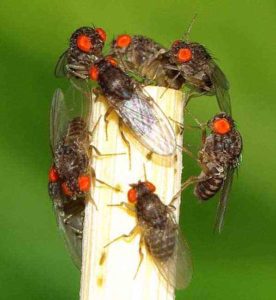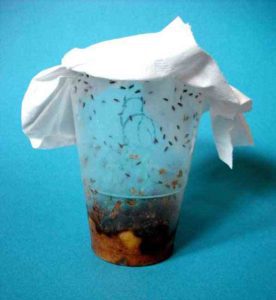Fruit Flies – essential food for baby chameleons
Fruit flies are an essential food for newly hatched chameleons, mantis nymphs and many smaller lizards and frogs. During the summer, if you leave a lump of banana lying around you will get lots of fruit flies but these wild ones can fly and are not so easily fed to your animals.
Life Cycle of Fruit Flies

The simplest container is a 500ml plastic cup with a paper tissue held on top by a small rubber band. This allows some ventilation without allowing wild flies in.
The food mixture is put on the bottom of the container to a depth of about 2cm. Above that, a small ball of plastic straw, ornamental straw, broken skewers or even upturned (unused) coffee filters are placed. These are necessary to stop the adults drowning and to provide a drier place for the pupae to form.
Feeding
There are numerous recipes on the Internet for breeding fruit flies but the food I find best is simply mashed banana. This is mixed with enough coarse digestive bran to make it a stiff paste. Nothing else is added.
Some experimentation will be needed to get the mix of banana and bran right – overnight the banana will start to ferment and be-come quite liquid but too much bran will cause the mix to dry out before the fruit fly cycle is complete.
Temperature
Both species of fruit fly do well at temperatures from 22 to 28°c. Warmer temperatures can help to increase production but excessive warmth will cause sterility among the flies and the culture will die out. Conversely, temperatures below about 20°c will slow production noticeably, although such low temperatures usually will not kill the flies.
Breeding Fruit Flies

Tip a large number of fruit flies into the container; about 100 to 150 is a good number if you can count them! In less than a week you should see small maggots in the mixture. The adult flies will continue to lay eggs even while the first maggots are growing. After a while, the number of adults will have dropped off dramatically but by then the maggot population should be very large.
About two weeks after starting your culture you should see the sides of the container almost black with newly hatched flies. Leave them for a few days. Take what you need for feeding but keep enough back to start a new culture.
To learn more about how to keep a good supply of nutritious insects on hand for your chameleon, check out this book: Breeding Insects as feeder food
